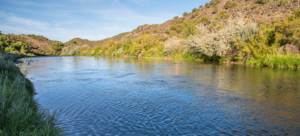New Mexico’s Waters One Year Post-Sackett
New Mexico is making progress but still much more to do to protect waterways

Media contact:
Tricia Snyder, 575-636-0625, tricia@nmwild.org
Mark Allison, 505-239-0906, mark@nmwild.org
Albuquerque, NM (May 24, 2024) – Tomorrow marks the one-year anniversary of the U.S. Supreme Court decision in Sackett v. EPA, the latest in a string of court decisions and regulatory changes that have eroded clean water protection across the country. Nowhere in the nation is more vulnerable than New Mexico.
At its core, the Sackett case was about wetlands and where they fit within the definition of Waters of the United States or those waters that are federally protected under the Clean Water Act. Because the decision determined that waters must have a “continuous surface connection” that is “indistinguishable” from other protected waters, specifically ones that are “relatively permanent”, it has also had devastating affects for ephemeral and intermittent waterways, or those waters that don’t flow year-round.
“The Clean Water Act was established in 1972 as a promise to communities across the country that we recognize the critical importance of clean water. The Sackett decision flies in the face of that promise,” said Tricia Snyder, rivers and waters program director for New Mexico Wild.
Here in New Mexico, ephemeral and intermittent streams make up most of our surface waters. Environmental advocacy organization, American Rivers, annually lists the top ten most endangered rivers in the nation. In 2024 for the first time ever, topping the list was not a specific river or stretch of a river but every river in the state of New Mexico.
Governor Lujan Grisham’s administration has long recognized the importance of this issue, and the Environment Department began setting up a state-led surface water quality permitting program before the Sackett decision was even finalized. Huge steps have been taken towards accomplishing this, including significant appropriations in the 2024 legislative session. But the hard work to get this program up and running is just beginning.
“We’re grateful to the Governor, the legislature, and the Environment Department for recognizing the critical need to protect New Mexico’s water quality,” continued Snyder, “Now we must work together to put this program on the ground as quickly as possible and work with communities to ensure those who know these waters best have a say in how its protected.”
New Mexico Wild, in coalition with its partner organizations, continue to advocate for a state-led program that is built off robust community input, includes adequate wetlands protections as well as other surface waters, includes a citizen suit provision like that in the federal Clean Water Act, and ensures meaningful government-to-government collaboration with those Tribes, Pueblos, and Nations that desire it. The time is now to ensure streams, rivers, and wetlands of the Land of Enchantment are protected from pollution and degradation—water can’t wait.
###

